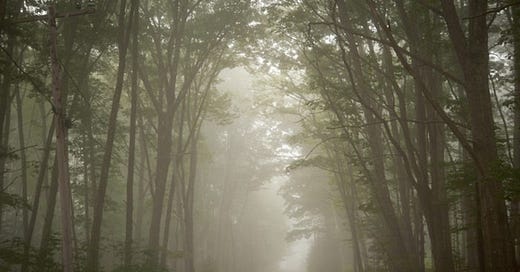The Stories of the Specter Moose
Since the late 19th century there is a large animal that stalked the woods of Northern Maine.
Superstitious woodsmen knew then that despite those that disbelieved it existed, this monster did indeed appear every few years to be seen only for a fleeting moment.
For years the "specter moose" would wander the woods of Maine The creature is an enormous moose, first seen in October 1891, by the famous guides Joe Francis and his brother Charlie.
These men were famous shots, but they could not hit the big moose, and this so worked upon their superstitious natures that they fled from the region and would not return. The Francis brothers, and all the other Indians and French Canadians who saw or heard about this moose, declared that the animal led a charmed life and that only a silver bullet could lay it low.
In 1892, Howard Van Ness actually got a chance to shoot at it, and ended up hiding under dead logs, as the animal sought out its foe. It was estimated the animal weighed about 2,500 pounds, twice as much the largest bull shot up to that time.
In 1894, a New York hunter saw the moose near Sourdnahunk Lake and fired .38 slugs into the animal without any effect. It charged and he had to run into a bear cave under a ledge to get away from it. He had to wait an hour until it left the area. He said the animal was about 15 feet at the shoulder points.
In 1899, Gilman Brown from Massachusetts saw a large moose on Roach River. It corresponded with the size given by the other hunters of the specter moose. Bullets seemed not to have any effect on it.
In 1900, George Kneeland, a bicyclist came across the "monster" as he traversed down a road. He thought at first it was a horse, until he took a better look and realized it was a moose. Then the animal lowered his head and "came straight for me with the speed of a locomotive". He abandoned the bicycle and climbed a tree to guarantee his safety. The man could not believe that he "had a nearby view of the fabulous animal that for nine years has been roaming the Maine woods, a terror to every human being that ever got within sight of him."
Reports by those that saw the animal guaranteed that no other moose matched it in stature, weight or spread of antlers. He was called a "specter moose" because of his dirty gray coat.
Clarence Duffy was the first to see him in the vicinity of Old Lobster Lake, and when he described what he saw, many laughed and thought he exaggerated. Until a few months later, a lumberman named John Ross saw the moose as well.
Hunters sought the prize, but he was not seen again until 1895 by Granville Gray, a taxidermist. The stories told by those who saw the animals said his antlers measured 10 to 12 feet across and he stood 15 feet high.
In September 1902, M. A. Cushing saw it in the area of Mt. Katahdin. He confirmed that it was as large as previously described. It disappeared from sight until November 1908, when it was sighted again at Lobster Lake with a herd of 16 other moose.
In January 1938, 36 years from the last sighting, a hunter in the Chesuncook reported seeing the "specter moose". Several took pot shots at it without any effect.
Not only his ghostly hue but also his keen scent, acute hearing and seemingly magical power of instant disappearance have built up the legend of a wraith.
Maine however was not the only one to report on a specter moose. In September 1923, a sighting was made of "ghost" moose in the forests surrounding the Tanana River in Alaska.
The "shadow" moose was said to be a well-known apparition among the Alaskan Indians. The appearance of the animal presaged a momentous event. "Sometimes the animal brings evil and sometimes it brings good fortune"
It was seen in the fall of 1897 and spring of 1898. According to the natives it foretold the discovery of gold in the Chilkoot and Klondike. However its appearance in 1912, warned of the eruption of the volcano of Mount Katmai, which spread ashes across thousands of miles. The hunting ground on Kodiak Island were buried.
The moose was seen again in 1918, and that years half of the native population died from the Spanish Influenza.
Albino moose do exist, but are rare. Indians call them “Spirit Moose”. However they are normal size, not what was described by different hunters throughout the years.










